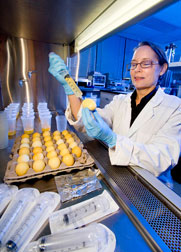



Salmonella Strain's Path to Virulence Uncovered
US - Agricultural Research Service (ARS) scientists have uncovered genetic evidence about the evolutionary path that transformed Salmonella enteritidis from an innocuous bacterium into a virulent pathogen.
S. enteritidis, like many bacteria, reproduces very quickly--every 20 minutes in optimal conditions, according to veterinary medical officer Jean Guard-Bouldin in the ARS Egg Safety and Quality Research Unit in Athens, Georgia.
Such a fast reproductive pace allows the organism to accumulate genetic variations. Only healthy competitors go on to reproduce, survive and develop the mechanisms needed to infect the egg. Using DNA analysis, Guard-Bouldin is looking at evolutionary evidence to determine how some S. enteritidis strains became pathogenic. Studying how S. enteritidis evolves and infects hens on the farm may someday help reduce levels of infection.
Guard-Bouldin and her colleagues found S. enteritidis strains to be so similar genetically that they appear identical, yet they may behave differently inside the hen. To distinguish between the apparently identical genomes, researchers must use a technique called "whole-genome mutational mapping" to analyze multiple strains.
Through these analyses, the researchers developed a timeline of when S. enteritidis first became capable of getting inside the egg from hen reproductive organs - approximately 36 years ago. It appears that a large-scale swap of DNA between strains, in association with the emergence of egg contamination, created a hybrid strain of S. enteritidis.
This hybrid strain had the ability to contaminate the internal contents of eggs. Later, it also split very quickly into two lineages, each carrying one virus. Both of the newly split lineages continued to evolve and eventually began to vary in their ability to contaminate eggs and to survive on the farm.











